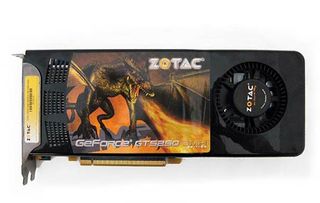GeForce 9600 GT/GTS 250/GTX 260 Non-Reference Roundup
Zotac GeForce GTS250 AMP! Edition

Zotac’s recipe for its GeForce GTS 250 AMP! Edition is simple: take a reference GeForce GTS 250 and squeeze some more performance out of it with an overclock. It’s a straightforward approach that works well, delivering higher performance for what we're expecting to be a low price (this card isn't yet selling at e-tail). Usually the tradeoff is extra heat and noise, but we’ll see how the Zotac card handles that a bit later.

Our first impressions were positive, as the GTS 250 comes in an attractive box with a window that allows you to see the card and the graphics on the cooler. Included in the bundle are a manual, a driver/utility CD, a Molex-to-PCIe power adapter cable, an HDMI audio cable, a DVI-to-VGA adapter, and a DVI-to-HDMI adapter. All good stuff, but once again there’s no SLI adapter included in this SLI-capable card (look to your motherboard bundle for that).
Zotac also went out of its way to include some actual retail software, which we don’t see as much of as we used to. There is a full version of 3DMark Vantage Advanced Edition, which is a nice addition for tweakers out there. Zotac also included a game, XIII Century: Death or Glory, which is a well-reviewed tactical real-time strategy title.


The card itself, as we mentioned earlier, is closely based on the reference model. On the downside, it’s somewhat large at 10" long and comes with a relatively loud reference cooler. On the positive side, we like cards that exhaust hot air out of the case instead of keeping it inside, where it can heat up other components. This is something we don't see as much on non-reference coolers as we used to. As well, the Zotac GeForce GTS 250 is the only card in our roundup that accommodates a single eight-pin PCIe power connector.

Stay on the Cutting Edge
Join the experts who read Tom's Hardware for the inside track on enthusiast PC tech news — and have for over 25 years. We'll send breaking news and in-depth reviews of CPUs, GPUs, AI, maker hardware and more straight to your inbox.
Current page: Zotac GeForce GTS250 AMP! Edition
Prev Page Asus ENGTS250 Dark Knight 1G, Cont’d Next Page Zotac GeForce GTS250 AMP! Edition, Cont’d-
Mottamort I was rather disappointed with this article. Not the article itself but with the slightly misleading Title/Intro. When clicking the article I thought I was going to find a massive battle between these vendors on different tiers, instead you show us different instances of 2 slightly different cards of the same type from one vendor....if that makes senseReply
I mean you have Gigabyte vs Gigabyte in the 9600gt section, Asus vs Asus in the 250 section and so on.
:-/ -
dragonsprayer Great articleReply
i wish it had more cards, i think you need 4 parts, try some back cards like the 4870x2 darkknight? good stuff as always!
thx! -
crisisavatar wow how is the gts 250 performing so close to the gtx 260 wasn't the gtx 260 20% faster ?Reply -
enterco It's not clear to me why are you comparing '3dmark score' when you should post 'GPU score'.... It's a graphics card comparision, not platform comparision.Reply -
randomizer entercoIt's not clear to me why are you comparing '3dmark score' when you should post 'GPU score'.... It's a graphics card comparision, not platform comparision.Nothing but the cards is changed so you're not comparing platforms.Reply -
acasel We cannot see clearly the bang for the buck card there if we ain't seeing some ati cards like the 4770 and others..Reply
The drop down menu sure is fast... :-) -
enterco randomizerNothing but the cards is changed so you're not comparing platforms.Sure. A reason more to show GPU score. 3dmark score is too much influenced by CPU's power, and it's no longer relevant, the way it used to be once...Reply
By using a Quad Core and a low-performing GPU you can achive same 3dmark score as using a dual core combined with a considerably stronger GPU, 3dmark Vantage gives too much credit to CPU. But the overall FPS in games it's often higher in the second case: dual core + better GPU. -
marraco Recent review showed the 260 being neck to neck with the 4870; both in price and performance, those cards are in the same point.Reply
Since my 8800GT should be between the 9600 and the 250, I guess that the best upgrade path is to buy a second 8800GT, reaching probably 260/4870 performance.
I searched the web for 8800GT SLI benckmark running in i7 920, but got no one single review...
I think that tomshardware should review non up-to-date cards as the 8800 and the ATI equivalents, in crossfilre/SLI, since for many users, it should make sense to buy a second card that to upgrade to a 260/4870.
older reviews on those cards does not accounted for the scalability on I7 x58 platform, and probably ATI and Nvidia dedicated more time tweaking drivers for newer cards, so maybe the 8800GT does not perform well today (the SLI on core 2/Quad did not worked very well in the past)
Most Popular

